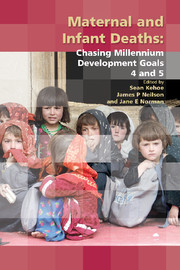Book contents
- Frontmatter
- Contents
- Participants
- Declaration of personal interests
- Preface
- The Millennium Development Goals
- SECTION 1 THE SIZE OF THE PROBLEM
- SECTION 2 CLINICAL PROBLEMS AND SOLUTIONS – MATERNAL
- SECTION 3 CLINICAL PROBLEMS AND SOLUTIONS – NEONATAL
- SECTION 4 TRAINING AND DEVELOPMENT
- SECTION 5 SPECIFIC CHALLENGES IN SPECIFIC COUNTRIES
- 17 Challenges faced in Afghanistan
- 18 Challenges faced in Zimbabwe
- 19 How Egypt has overcome the challenges
- 20 Learning from the achievements in Sri Lanka
- SECTION 6 CONSENSUS VIEWS
- Index
20 - Learning from the achievements in Sri Lanka
from SECTION 5 - SPECIFIC CHALLENGES IN SPECIFIC COUNTRIES
Published online by Cambridge University Press: 05 February 2014
- Frontmatter
- Contents
- Participants
- Declaration of personal interests
- Preface
- The Millennium Development Goals
- SECTION 1 THE SIZE OF THE PROBLEM
- SECTION 2 CLINICAL PROBLEMS AND SOLUTIONS – MATERNAL
- SECTION 3 CLINICAL PROBLEMS AND SOLUTIONS – NEONATAL
- SECTION 4 TRAINING AND DEVELOPMENT
- SECTION 5 SPECIFIC CHALLENGES IN SPECIFIC COUNTRIES
- 17 Challenges faced in Afghanistan
- 18 Challenges faced in Zimbabwe
- 19 How Egypt has overcome the challenges
- 20 Learning from the achievements in Sri Lanka
- SECTION 6 CONSENSUS VIEWS
- Index
Summary
Introduction
Sri Lanka has achieved a high status in maternal and newborn health. This island of 62 705 km has a population estimated to be 20.2 million (in 2008), yielding a population density of 322 per km2. Social stratifications, although present, do not affect the delivery of health care to all its citizens. A democratic parliamentary system of government ensures the development of country-specific health interventions. These have been strengthened even more to meet the local health needs following the devolution of power to provinces, districts and divisions.
Since 1947, the government of Sri Lanka has provided education to its people up to university graduation without a fee. Although, by academic selection, fewer than 20% of those qualifying at the General Certificate of Education ‘Advanced’ level (GCE ‘A’ level) examination are offered places at the state universities, increasing numbers of the remainder seek higher education at paid courses conducted by non-governmental higher education institutions. All these inputs contribute to the literacy rate of 91.8%.
In a similar manner, the government of Sri Lanka provides a free health service, without a user fee, from birth throughout life. The government health facilities, which are available throughout the country at basic, intermediate and tertiary levels, have also introduced some very advanced therapeutic procedures. For those who wish to obtain curative health services from the non-governmental providers, primary to tertiary care is also available in the private sector establishments. Approximately 4% of total deliveries in the country occur in private sector hospitals.
- Type
- Chapter
- Information
- Maternal and Infant DeathsChasing Millennium Development Goals 4 and 5, pp. 307 - 316Publisher: Cambridge University PressPrint publication year: 2010



